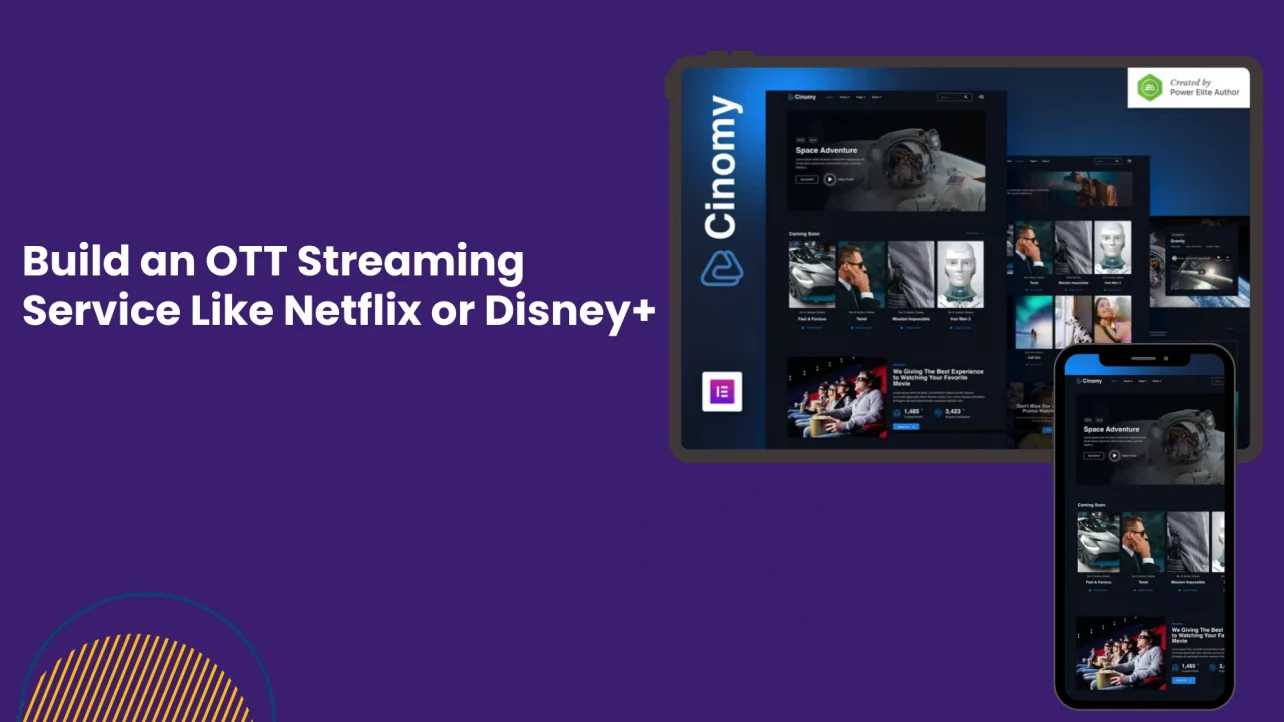Introduction: Why Businesses Want to Build OTT Platforms Like Netflix & Disney+
In today’s digital-first world, video consumption is no longer confined to traditional TV. Audiences want content on their terms — anytime, anywhere, on any device. This behavioral shift has led to the exponential growth of OTT streaming services, with platforms like Netflix, Disney+, and Amazon Prime Video setting the global standard. Businesses across industries — entertainment, fitness, sports, education, media houses, broadcasters, and even churches — now see OTT as the gateway to audience engagement and new revenue streams.
Netflix’s success comes from its massive subscription-based model (SVOD) and original content investments, while Disney+ leverages its brand legacy, exclusive licensing, and global fan base. By building OTT platforms, businesses can:
- Establish direct-to-consumer relationships.
- Customize experiences with personalized video recommendations.
- Gain recurring income through subscription or hybrid monetization models.
- Tap into global markets with multi-device, multi-language, and multi-platform support.
The market for OTT platforms is expected to surpass $500 billion by 2030, making it one of the most profitable digital businesses of the future.
What Is an OTT Streaming Service?
An OTT (Over-the-Top) streaming service delivers content directly over the internet, bypassing traditional broadcasting methods like cable and satellite. OTT solutions empower users to stream movies, TV shows, sports, live events, and even educational content instantly from smartphones, smart TVs, desktops, or streaming devices.
Unlike cable TV, OTT services allow:
- On-demand playback (users choose what to watch).
- Flexible monetization models (ads, subscriptions, or pay-per-view).
- Cross-device continuity (resume a video on mobile after watching it on TV).
Examples include:
- Netflix & Disney+: Subscription-driven premium OTT platforms.
- YouTube: A free, ad-supported OTT platform (AVOD).
- Hulu & HBO Max: Platforms offering hybrid monetization strategies.
Businesses use OTT platform providers or custom OTT solution development to launch branded services without building infrastructure from scratch.
Key Features of Successful OTT Platforms
OTT platforms succeed because they combine technology, content, and user experience. The most important features include:
- Content Management System (CMS): For uploading, categorizing, and managing video libraries.
- Adaptive Bitrate Streaming (ABR): Adjusts video quality in real-time based on internet speed, ensuring smooth playback.
- Multiple Monetization Models: Supporting SVOD, TVOD, AVOD, FAST channels, and hybrids.
- Scalability: Cloud-native OTT platforms that handle millions of concurrent viewers during live events.
- Security & DRM: Encryption, watermarking, and digital rights management to prevent piracy.
- Advanced Video Analytics: Tracking engagement, churn, watch time, and ad performance.
- User-Friendly Interface: Personalization, recommendations, and multi-language support to keep users engaged.
These features are non-negotiable for competing with giants like Netflix or Disney+.
Step 1: Define Your Niche and Business Model
The OTT space is crowded, but niche targeting gives businesses an edge. Consider:
- Sports OTT solutions (live streaming, highlights, replays, fantasy leagues).
- Fitness OTT apps (yoga, workout libraries, nutrition coaching).
- Educational VOD platforms (online courses, tutorials, training videos).
- Faith-based OTT streaming (live church services, community content).
- Entertainment OTT solutions (regional movies, indie films, documentaries).
Your business model must align with your audience. For example:
- SVOD: Ideal for content-rich libraries (Netflix).
- TVOD: Works best for premium events or single-purchase videos (boxing matches, live concerts).
- AVOD: Good for ad-driven, free-to-access platforms (YouTube).
- Hybrid models: Offer flexibility and maximize revenue (Hulu).

Step 2: Choose the Right OTT Monetization Model
Monetization determines profitability. OTT platforms use:
- SVOD (Subscription VOD): Recurring fees for unlimited access. Great for platforms with strong content catalogs.
- TVOD (Transactional VOD): Pay-per-view or download-to-own models. Best for sports events, concerts, or exclusive films.
- AVOD (Advertising VOD): Free to users but ad-supported. Ideal for mass audiences and broadcasters.
- FAST Channels: Linear channels with ad support. Popular for TV-like experiences.
- Hybrid Monetization: Mixing subscriptions + ads + transactions to diversify income.
Advanced OTT video analytics helps test and adapt monetization models to maximize ROI.
Step 3: Build or Choose the Right OTT Technology Stack
Your OTT technology stack is the backbone of your streaming service. A poorly designed stack can cause buffering, crashes, and user dissatisfaction, while a well-structured one ensures smooth performance even under heavy traffic.
It must include:
- Video Encoding & Transcoding: Converts raw video into multiple resolutions (240p–4K HDR, 8K in advanced setups) for adaptive bitrate streaming (ABR) so users always get the best quality for their internet speed.
- Content Delivery Network (CDN): Distributes content globally with low latency and zero downtime. Essential for live sports streaming and large-scale events.
- OTT Middleware: Manages user authentication, subscription billing, recommendations, and parental controls. Acts as the “command center” of your OTT app.
- Payment Gateways: Must support multiple currencies, wallets, and in-app purchases for global audiences. Integration with PayPal, Stripe, Razorpay, and carrier billing ensures smooth transactions.
- Cloud Infrastructure: Provides elastic scalability to handle traffic spikes during blockbuster releases or live sports finals. Cloud-native OTT platforms are now the industry standard.
- APIs & SDKs: Offer flexibility to integrate with third-party apps such as ad servers, recommendation engines, or video conferencing tools.
Choosing between custom development and white-label OTT solutions depends on budget, timeline, and feature requirements. Startups often go with white-label, while enterprises may invest in custom OTT platforms.
Step 4: Select an OTT Platform Provider or Build from Scratch
Choosing the right approach determines your time-to-market, costs, and customization levels.
From Scratch:
- Provides full control over architecture, features, and design.
- Offers long-term ownership of technology.
- Requires a dedicated development team, cloud hosting setup, and 12–24 months of work.
- Cost often starts from $300k+, excluding content licensing and marketing.
- Ideal for large enterprises, broadcasters, and media houses.
OTT Platform Providers:
- Provide ready-to-launch, white-label OTT platforms.
- Quicker deployment (as fast as a few weeks).
- Built-in features: monetization, DRM security, analytics, CDN, and customer support.
- More cost-efficient and scalable for SMBs, broadcasters, content creators, and niche players.
- Top providers include Innocrux, Uscreen, Dacast, and Brightcove, each offering custom OTT solution development for specific industries like sports, fitness, or education.
Step 5: Content Acquisition and Licensing Strategies
Content is the core driver of subscriber growth and retention. Even the most advanced platform will fail without a compelling content library.
Key strategies include:
- Produce Originals: Exclusive series and movies (like “Netflix Originals” or “Disney+ Star Wars spinoffs”) help build loyalty and brand identity.
- License Premium Content: Secure rights from production houses, sports organizations, or film studios. Licensing agreements differ by region, so compliance is critical.
- Encourage User-Generated Content (UGC): Platforms targeting niche audiences (fitness coaches, indie filmmakers, educators) can leverage creator-driven ecosystems.
- Regional/Niche Content: Cater to localized preferences — e.g., Hotstar’s focus on cricket and regional movies helped it dominate India’s OTT space.
A good content strategy balances exclusive originals, licensed blockbusters, and user-driven uploads.
Step 6: User Experience & UI/UX Design for OTT Apps
Your user interface and experience directly impact engagement, retention, and churn rates. Even great content fails if navigation feels clumsy.
Focus on:
- Personalized dashboards: Tailor recommendations using AI-driven insights.
- Continue watching & watchlists: Encourage longer viewing sessions.
- Advanced search & filters: Help users find exactly what they want, including language, genre, or release year filters.
- Seamless cross-device playback: Users can switch from mobile to TV without losing progress.
- Accessibility features: Subtitles, closed captions, screen-reader support, and voice search.
- UI branding: Consistent themes, color palettes, and layouts aligned with your brand identity.
Disney+ excels here with category hubs (Marvel, Pixar, Star Wars) that enhance navigation and increase binge-watching.
Step 7: Multi-Device Support Across Platforms
To succeed globally, OTT apps must be device-agnostic. Audiences want to watch content on any screen at any time.
Your platform should support:
- Smart TVs (Samsung Tizen, LG WebOS, Android TV).
- Mobile Apps (iOS & Android with offline viewing).
- Web Browsers (Chrome, Safari, Firefox, Edge).
- Streaming Devices (Roku, Firestick, Chromecast, Apple TV).
- Gaming Consoles (PlayStation, Xbox).
- Wearables & AR/VR headsets (future trend for immersive viewing).
Providing a consistent viewing experience across devices increases user satisfaction and reduces churn.
Step 8: Integrate Advanced Features
OTT competition is fierce — advanced features help your platform stand out:
- AI-driven personalization: Netflix-style algorithms recommending content.
- Multi-language dubbing & subtitles: Essential for global expansion.
- Offline downloads: Keeps mobile users engaged without internet.
- 4K HDR & Dolby Atmos: Premium streaming quality for modern devices.
- Social features: Watch parties, user reviews, chat integrations.
- Live streaming: Crucial for sports, concerts, e-learning, or webinars.
- Parental controls: Safe viewing for kids and family users.
- Interactive content: Quizzes, polls, or AR experiences.
Advanced features increase user retention and improve monetization opportunities.
Step 9: Video Analytics and Performance Tracking
Without analytics, businesses fly blind. Data-driven decisions are key to scaling an OTT platform.
Track:
- User behavior: Play counts, watch history, content completion rates.
- Engagement metrics: Average session time, binge-watching frequency.
- Revenue insights: Subscription renewals, churn analysis, ad CTR.
- Performance metrics: CDN health, buffer rates, video start times.
- Content performance: Which shows/movies drive subscriptions or ad revenue.
Platforms like Innocrux offer real-time analytics dashboards with AI-driven predictions, helping businesses adjust content acquisition, pricing models, and marketing strategies instantly.
Step 10: Testing, Launch, and Scaling the OTT Platform
The final phase ensures your OTT platform is bug-free, secure, and scalable.
Testing must include:
- Load testing: Simulate millions of concurrent viewers (sports finals, movie premieres).
- Cross-device testing: Optimize for all screen sizes, operating systems, and browsers.
- Security testing: Prevent piracy, DDoS attacks, and account hacks.
Scaling requires:
- Cloud-native OTT infrastructure: Auto-scale servers based on demand.
- AI-driven content delivery: Predictive caching for smoother streaming.
- Continuous updates: Rolling out new features, UX improvements, and integrations.
- Global CDN expansion: Ensure latency-free experiences for international audiences.
A phased launch strategy (beta release → soft launch → global release) minimizes risks and allows real-world feedback collection before scaling.

Challenges in Building an OTT Streaming Service
- High setup and content costs – Building infrastructure, acquiring licenses, and securing exclusive content requires heavy investment, making it tough for startups.
- Piracy and security threats – Content theft, unauthorized streaming, and account sharing impact revenue. Implementing DRM, watermarking, and anti-piracy tools is critical.
- Intense competition – Giants like Netflix, Disney+, Amazon Prime, and regional OTT platforms dominate the market, forcing new entrants to differentiate with niche content or features.
- Regional licensing issues – Securing streaming rights across different countries is complex due to copyright laws, language barriers, and varying consumer demands.
- Churn and user retention challenges – High subscription fatigue and easy cancellations mean businesses must focus on engagement, personalized recommendations, and loyalty programs.
- Technical scalability – Handling millions of concurrent users without downtime requires robust cloud and CDN infrastructure.
- Monetization hurdles – Choosing the right balance between SVOD, AVOD, TVOD, or hybrid models is often difficult for new OTT providers.
Cost of Building an OTT Platform Like Netflix or Disney+
- Basic OTT platform: $30k–$80k – Covers essential features like video library, user accounts, payment integration, and a simple CMS.
- Mid-tier: $100k–$250k – Includes advanced features like multi-device apps, adaptive bitrate streaming, DRM protection, and analytics dashboards.
- Advanced custom OTT solution: $300k–$500k+ – End-to-end OTT platform with AI-driven recommendations, live streaming, advanced CDN, white-label branding, and third-party integrations.
- Additional recurring costs:
- Content licensing – Securing premium shows/movies.
- Cloud hosting & CDN charges – Ensuring smooth global delivery.
- App maintenance & updates – Keeping apps bug-free and optimized.
- Marketing & customer acquisition – Paid ads, influencer partnerships, and referral programs.
- Compliance & legal costs – Adhering to data privacy laws like GDPR and regional broadcasting rules.
- Content licensing – Securing premium shows/movies.
Future Trends in OTT Streaming Services
- AI/ML personalization for smarter engagement – Predictive algorithms will curate hyper-personalized libraries for each user.
- 5G streaming with near-zero buffering – Faster networks will improve live sports streaming and 4K/8K content experiences.
- AR/VR immersive experiences in VOD – Interactive concerts, VR theaters, and metaverse-based OTT platforms will emerge.
- FAST channels for free ad-supported content – Platforms will launch free linear-style channels to capture AVOD-driven audiences.
- Blockchain & NFTs for digital ownership – Creators may tokenize movies or shows, letting users own unique digital rights.
- Interactive live streaming (gamified sports & events) – Real-time polls, betting, and gamification will boost engagement.
- Super apps & bundled services – OTT platforms may merge with gaming, e-learning, and music streaming for all-in-one subscriptions.
- Localized & niche OTT platforms – Growth in regional language streaming and platforms dedicated to sports, fitness, or education.
Conclusion
Building an OTT streaming platform like Netflix or Disney+ goes beyond just technology—it’s about combining innovation, content strategy, and user experience. Businesses must choose between white-label OTT solutions for quick deployment or custom OTT platforms for full control and scalability.
Success in OTT depends on:
- Offering diverse monetization models (SVOD, AVOD, TVOD, FAST).
- Delivering high-quality content and exclusive originals.
- Ensuring seamless multi-device experiences.
- Using data-driven insights and video analytics to boost engagement.
- Maintaining content security and piracy protection.
The future of OTT lies in personalization, immersive technologies, and global reach. With the right OTT solution provider, content partnerships, and growth strategy, businesses can compete with top players and capture loyal audiences worldwide.


No comments yet